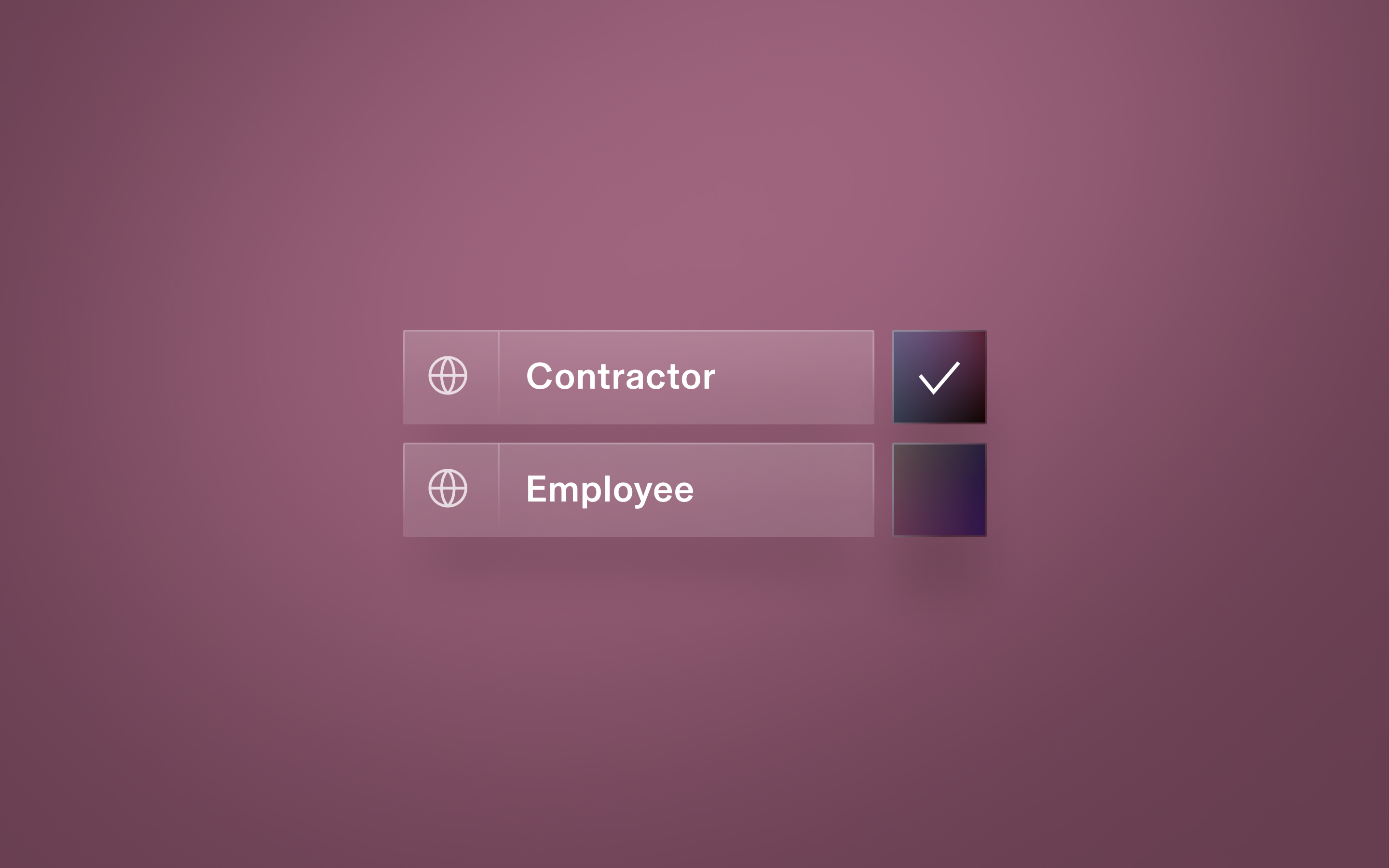How to (legally) hire international contractors—from 2 employment attorneys

Hiring contractors is a cost-effective way to flexibly scale up your workforce—and international contractors open up a global pool of diverse talent to businesses all over the world. But when you hire international contractors, it’s absolutely crucial to do it legally—compliance mistakes open your business up to major legal and financial risks.
Christina Baggett is one of Rippling’s lead attorneys on the PEO and EOR team. She’s been practicing employment law for 13 years. Caroline Esser, Assistant General Counsel on the PEO and EOR team, worked in copyright and antitrust litigation before moving in-house and beginning to specialize in employment law and product counseling with Rippling. In our recent webinar, we took some of the mystery out of legally hiring international contractors. Read about everything we covered—plus, watch the webinar on demand so you don’t miss out on any of the information we shared about this important topic.
Why hiring independent contractors has become so popular
Today’s business owners are keen to unlock the many benefits of working with independent contractors:
- Financial benefits, as they have specialized skills and therefore don’t require expensive training. In addition, they are generally expected to provide their own tools and equipment, obtain their own healthcare benefits, and make their own social security contributions.
- Specialized expertise that may not already exist within your organization—and doesn’t require investment in training or onboarding.
- Increased productivity, as they work on defined projects or goals and generally don’t participate in things like team meetings and training—important aspects of work for employees, but also work that takes time away from their day-to-day responsibilities.
Furthermore, as remote work has proliferated around the globe, it’s only become easier to find and work with the best contractors—even if they’re across international borders. During our recent webinar, 77% of attendees said they’ve hired an international employee or contractor for their company, while another 10% said they haven’t yet, but plan to in the future. One in four of Rippling’s customers has at least one international contractor; in fact, 38% of all the contractors on Rippling are based in a different country than the company they work for.

Learn how to compliantly hire international contractors from Rippling legal experts
Watch the webinarKey differences between employees and independent contractors
Many businesses perceive hiring contractors as easier and less risky than hiring employees, but that isn’t always the case. Before diving into the risks, though, it’s important to understand the differences between the two classifications:
- A contractor is a self-employed individual who provides services to another entity under terms specified in a contract.
- An employee is an individual hired by a company to work on a regular basis and is entitled to certain benefits and protections.
Some other key differences employers should know:
Independent contractors
Employees
Work on a temporary, per-project basis, often for several companies simultaneously.
Work on a regular basis under direction, control, and training of their employer.
Purchase their own equipment and set their own hours and schedule.
Have equipment and tools to complete their work provided for them by their employer.
Generally, send invoices to the company and are responsible for self-employment taxes.
Employer is responsible for taxes and deductions from regular paychecks.
Are not protected by employment laws that apply to employee/employer relationships.
Are protected by employment laws that apply to employee/employer relationships.
Different tests, different results
Keep in mind, however, that the exact legal distinctions between contractors and employees are defined by the laws in each country, so they can vary a bit around the world. Depending on where you hire (and, in some cases, even which government agency is asking), the test for whether a worker should be classified as an independent contractor or an employee will vary—and different tests applied to the same situation may yield different results.
Here’s an example of what that looks like in practice, showing the tests used to determine worker classification in three different countries. Keep in mind that the tests applied to a situation depend on where the contractor is based—not your business:
Country
Test
United States
As of 2024, the DOL uses a six-part test where all parts are given equal weight:
- Nature and degree of control: Whether the contractor sets their own hours, work location, etc.
- Permanency of the relationship: Whether the contractor works on a short-term or project basis or indefinitely.
- Skill and initiative: Whether the contractor brings specialized skills or receives training and onboarding from the employer.
- Investments by worker and employer: Whether the contractor has invested in their own tools, education, etc.
- Chance of profit and loss: Whether the contractor can profit from working more efficiently and/or lose money on their business dealings.
- Extent to which the work is integral to business: Whether the business could function without the contractor’s contributions.
France
French courts and agencies look to a number of factors:
- Much emphasis is placed on the concept of “subordination”, which is the employer’s ability to give orders and direction, control the execution of the work, and/or discipline the employee.
- The analysis of a worker’s status of contractor or employee is assessed by judges through a case by case analysis, taking into consideration various factors such as the worker’s integration into the employer’s day-to-day business and organization, his/her economic dependence towards the employing/client entity, the monitoring of the worker’s performance or working time, warnings, etc.
United Kingdom
UK courts have established a four-part test, which includes:
- Mutuality of obligation: Whether the contractor is obligated to accept work, or if they can decline offers of work without jeopardizing their relationship with the employer.
- Personal service: Whether the contractor must perform the work themselves, or if they have the right to subcontract it, or substitute another qualified individual to complete it.
- Control: Whether the contractor provides their own tools and equipment, receives training and supervision, and how integrated they are into the employer’s company.
Consequences of misclassification
While the tests used to determine whether a worker has been misclassified can vary by country, the consequences if your business is found to have misclassified an employee as an independent contractor are pretty consistent across international borders. They often include:
- Back taxes, which can also come with fines and penalties for late payment.
- Misclassification penalties, which can include back wages, unpaid overtime, and additional penalties depending on the jurisdiction.
- Civil lawsuits, or even class actions in some jurisdictions.
- Legal penalties, including jail time.
- Reputational damage, as your company may be seen as trying to take advantage of labor or as weak on compliance.
Not sure if you’re classifying your employees and contractors correctly? You’re not alone—during our webinar, only 34% of attendees said they were confident in their ability to correctly classify workers. Mitigate risk to your business by checking if you’re accurately classifying your workers around the globe with our free employee misclassification analyzer, which can serve as a good starting point for your classification analysis.
How to legally hire contractors internationally
If you want to take advantage of the benefits of hiring global contractors while mitigating the risks of misclassification, read on for our top tips on hiring and paying international contractors.
Legally compliant contracts
One of the most important things you need to legally hire an international contractor is a legally compliant contract. Something companies have to keep in mind is that it’s not enough for the contract to say they’re an independent contractor if all other aspects of the relationship suggest they’re an employee.
When drafting a contract for an international contractor, consider including the following elements:
1. The specifics of the working relationship
This means you should:
- Make clear that it’s an independent contractor-client relationship.
- Define what projects or services the contractor will provide.
- Make clear that the contractor will be solely responsible for the manner and hours in which their services are performed (i.e. they have control over how their work gets done).
2. No exclusivity of services provision
Full-time employees generally perform services exclusively for their employer, but contractors can perform services for more than one business at a time. The contract should not say that you and the contractor have an exclusive relationship.
3. The contract duration
Most contractor agreements are for a set term or project—and end thereafter. Spell that out in the agreement so it isn’t open-ended or indefinite like employment agreements often are.
4. A termination provision
The termination provision should spell out how the parties can terminate the relationship if it’s not working out or services aren’t needed anymore. It should also say how much notice they should provide if they do choose to end the agreement early.
Protecting intellectual property
Either in the contract or in a separate agreement, make arrangements to protect your intellectual property rights under your work agreement with the contractor.
Generally, it’s a good idea to think about assigning rights to IP created by the contractor during the work agreement to your company.
Also, you might want to consider including a provision to ensure they keep confidential any proprietary information learned through the course of the contractor relationship.
Tax forms
The next step is to complete the correct tax forms for the international contractor, which will vary depending on the country where they file taxes.
For example, if you’re a US company working with a US contractor, they should fill out a Form W-9. If you’re a US company working with an international contractor, they should fill out a Form W-8BEN.
Payroll software like Rippling can help you make sure you collect the right forms for the appropriate country and automatically onboard contractors around the world with locally compliant paperwork based on where they live.
Data privacy and privacy law compliance
Finally, make sure you adhere to regulations around data handling and privacy to protect contractor information and prevent legal issues. This is especially important if you hire international contractors in EU countries covered by GDPR.
How to pay independent contractors
Legally hiring contractors is only the first step. They also need to get paid.
As an employer, you need a system that can create, accept, and approve invoices. Having invoices from contractors can help decrease your misclassification risk by acting as a record of contract work.
You’ll also need to think through some other details about when and how you’ll handle international contractor payments. For example:
- Will the contractor be paid in their local currency or US dollars?
- How long will it take for your payment to reach them?
- What’s their preferred payment frequency? By the hour? At intervals? As milestones are met?
To recap:
- Hiring international contractors provides many benefits for businesses in an increasingly globalized market;
- To hedge against potential misclassification risks it is important to do a thorough classification analysis that is jurisdiction-specific prior to entering into an independent contractor-client relationship with a worker;
- Don’t overlook key contract provisions, particularly when it comes to IP and confidentiality;
- Consider utilizing an Employer of Record (EOR) service if the worker does not meet the local contractor requirements.
With Rippling, you can manage and pay all the contractors you work with, whether they’re domestic or international. Furthermore, if you don’t believe that the worker should be classified as a contractor and therefore need to bring them on as an employee, we also offer Employer of Record (EOR) services in many countries so you don’t have to pass up good talent just because they happen to live abroad.
Learn about all of this and more in our webinar.
If you still have any questions, Rippling is here to help. With expert legal counsels and HR advisors around the globe, we've tailored our product and services to teams asking the questions that led you here.
Disclaimer: Rippling and its affiliates do not provide tax, accounting, or legal advice. This material has been prepared for informational purposes only, and is not intended to provide or be relied on for tax, accounting, or legal advice. You should consult your own tax, accounting, and legal advisors before engaging in any related activities or transactions.











